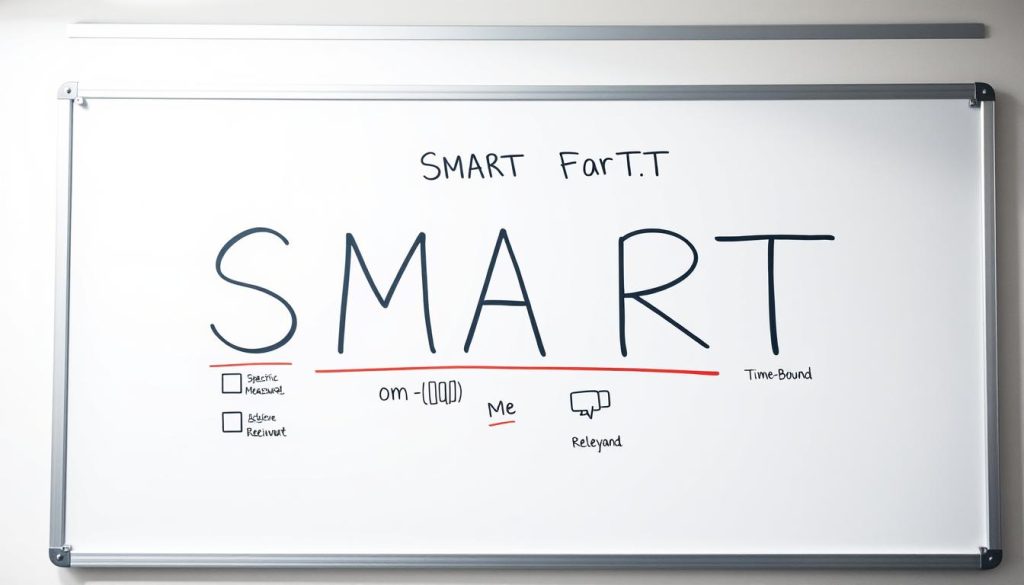Are you stuck in a career rut, wondering if there’s more to professional life than your current role? Setting clear career objectives can be the key to unlocking a more fulfilling professional journey.
Having clear career aspirations not only guides your professional path but also enhances overall job satisfaction. It’s about understanding what you want to achieve and taking deliberate steps towards those goals.
Achieving career aspirations is a journey of personal growth and professional development. It involves identifying your strengths, addressing your weaknesses, and seizing opportunities that align with your career objectives.
Key Takeaways
- Setting clear career goals enhances professional journey and job satisfaction.
- Career goal setting involves understanding personal strengths and weaknesses.
- Achieving career aspirations is a path to personal growth and fulfillment.
- Clear career objectives guide professional development.
- Identifying and seizing opportunities is crucial for career advancement.
The Power of Purposeful Career Planning
As professionals navigate their career paths, the importance of purposeful planning cannot be overstated. Purposeful career planning is essential for achieving professional success and personal fulfillment.
Why Career Goals Matter in Today’s Professional Landscape
Career goals serve as a guiding force, providing direction and focus in a rapidly changing work environment. By setting clear objectives, professionals can better navigate the complexities of their chosen field and make meaningful progress toward their aspirations.
The Psychological Benefits of Goal-Directed Work
Achieving career milestones not only enhances one’s professional standing but also has profound psychological benefits. It boosts self-esteem and confidence, leading to greater overall well-being. By aligning daily tasks with long-term career aspirations, individuals can experience a sense of purpose and fulfillment in their work.
How to Set Career Goals and Achieve Them
Establishing clear career goals is the foundation upon which successful professional development is built. To achieve career success, individuals must first understand their professional aspirations and then craft a strategic plan to reach their objectives.
Self-Assessment: Understanding Your Professional Aspirations
Self-assessment is a critical step in setting career goals. It involves understanding your core values, passions, and current skills. This process helps individuals identify areas of strength and opportunities for growth.
Identifying Core Values and Passions
Identifying your core values and passions is essential to creating a fulfilling career. When your career aligns with your values and passions, you are more likely to be motivated and satisfied. Reflecting on what matters most to you can help guide your career decisions.
Evaluating Your Current Skills and Competencies
Evaluating your current skills and competencies is vital to understanding your professional standing. This assessment helps identify gaps in your skillset and areas for improvement. Consider using tools like skills assessments or career development workshops to gain insights into your professional abilities.
| Skill Category | Current Level | Desired Level |
|---|---|---|
| Communication | Intermediate | Advanced |
| Leadership | Basic | Intermediate |
| Problem-Solving | Advanced | Expert |
Crafting Goals That Align with Your Career Vision
Crafting career goals that align with your professional vision is crucial for success. Your goals should be specific, measurable, achievable, relevant, and time-bound (SMART). This framework ensures that your goals are clear and attainable.
“The future belongs to those who believe in the beauty of their dreams.” – Eleanor Roosevelt
Balancing Ambition with Realism
Balancing ambition with realism is key to achieving career goals. While it’s essential to be ambitious, setting unrealistic goals can lead to burnout and disappointment. Breaking down larger goals into smaller, manageable tasks can help maintain motivation and progress.
The SMART Framework for Professional Goal Setting
Effective career planning requires a structured approach to goal setting, and the SMART framework is a powerful tool to achieve this. By setting Specific, Measurable, Achievable, Relevant, and Time-bound goals, professionals can create a clear roadmap for their career advancement.
Specific: Defining Clear and Focused Objectives
The first step in applying the SMART framework is to define specific objectives. This involves clearly articulating what you want to achieve, avoiding vague statements. For instance, instead of “I want to be successful,” a specific goal would be “I aim to become a senior software engineer within the next three years.”
Measurable: Establishing Concrete Success Criteria
To ensure progress can be tracked, goals must be measurable. This means establishing concrete criteria that will be used to measure success. For example, “I will increase my sales revenue by 20% within the next 12 months” is a measurable goal.

Achievable: Setting Challenging Yet Attainable Goals
Goals should be achievable, meaning they are challenging yet realistic based on your current resources and constraints. Setting unattainable goals can lead to discouragement, while achievable goals foster motivation.
Relevant: Ensuring Alignment with Career Trajectory
It’s crucial that goals are relevant to your overall career aspirations. This ensures that achieving the goal will have a meaningful impact on your career trajectory. Aligning your goals with your long-term vision helps maintain focus and direction.
Time-bound: Creating Meaningful Deadlines
Finally, goals should be time-bound, with specific deadlines. This creates a sense of urgency and helps prioritize tasks. For example, “I will complete a professional certification course within the next six months” is a time-bound goal.
By applying the SMART framework, professionals can create a structured and effective approach to achieving their career goals.
Developing a Comprehensive Career Development Plan
A comprehensive career development plan serves as a roadmap for your professional growth. It outlines the steps necessary to achieve your career goals and provides a clear direction for your professional journey.
Conducting a Gap Analysis of Skills and Experience
The first step in creating a career development plan is to conduct a gap analysis. This involves assessing your current skills and experience against the requirements of your desired career position.
- Evaluate your current strengths and weaknesses.
- Research the requirements of your target career role.
- Identify the gaps between your current situation and your career goals.
Identifying Strategic Growth Opportunities
Once you have identified your skill gaps, the next step is to find strategic growth opportunities. This can include various pathways such as education, training, and professional certifications.
Educational and Training Pathways
Pursuing additional education or training can be a significant step in career development. This could range from formal degrees to online courses and workshops that enhance your skills.
Professional Certifications and Credentials
Obtaining professional certifications can also be beneficial. These credentials not only enhance your knowledge but also make your profile more attractive to potential employers.
Establishing Clear Milestones and Checkpoints
To ensure you are on track with your career development plan, it’s essential to establish clear milestones and checkpoints. These help in tracking your progress and making necessary adjustments to your plan.
- Set specific, measurable goals.
- Establish regular review dates to assess your progress.
- Adjust your plan as needed based on your progress and changing circumstances.
Actionable Strategies for Reaching Career Milestones
Achieving career milestones requires a strategic approach that involves breaking down large goals into smaller, manageable tasks. To make steady progress toward your career objectives, it’s crucial to have a clear plan and the right support systems in place.
Breaking Down Goals into Daily and Weekly Actions
To achieve your career goals, it’s essential to break them down into smaller, actionable steps. This involves creating a schedule and setting specific targets for daily and weekly tasks that align with your long-term objectives. By doing so, you can make consistent progress and stay focused on what’s important.
For instance, if your goal is to develop a new skill, you might dedicate 30 minutes each day to online courses or practice exercises. Tracking your progress and adjusting your schedule as needed will help you stay on track.

Building a Supportive Professional Network
A supportive professional network is vital for achieving career milestones. This network can provide valuable guidance, support, and opportunities that can help you grow professionally.
Finding Mentors and Sponsors
Mentors and sponsors can play a significant role in your career advancement. Mentors offer guidance and advice based on their experience, while sponsors can advocate for you within their organization, helping you access new opportunities.
Leveraging Peer Relationships
Peer relationships are also crucial as they provide a support system and can lead to collaborative opportunities. Engaging with your peers through industry events, online forums, or professional groups can help you stay connected and informed about industry trends.
Developing Accountability Systems
Developing accountability systems is critical to ensuring you stay on track with your career goals. This can involve regular check-ins with a mentor or peer, tracking your progress through a journal or app, or setting reminders for important milestones.
By implementing these strategies, you can maintain momentum and make adjustments as needed to achieve your career objectives.
Overcoming Obstacles to Goal Achievement
Achieving career goals is rarely a smooth journey, but understanding how to overcome obstacles can make all the difference. As you work towards your career aspirations, it’s essential to anticipate and prepare for potential roadblocks.
Identifying and Addressing Common Career Roadblocks
Common career roadblocks include lack of relevant experience, limited professional networks, and insufficient skills. To address these challenges, it’s crucial to conduct a thorough self-assessment and identify areas for improvement. By doing so, you can create targeted strategies to overcome these obstacles and stay on track towards your goals.
Strategies for Maintaining Motivation During Challenges
Maintaining motivation is vital when facing career challenges. One effective strategy is to break down larger goals into smaller, manageable tasks, allowing you to celebrate incremental successes and stay motivated. Additionally, surrounding yourself with a supportive professional network can provide encouragement and valuable guidance during difficult times.
Developing Professional Resilience and Adaptability
Developing professional resilience and adaptability is critical for overcoming career setbacks. This involves cultivating a growth mindset, being open to learning from failures, and adapting your strategies as needed. By doing so, you can navigate career challenges more effectively and stay focused on your long-term goals.
Measuring Progress and Refining Your Career Aspirations
The path to career success involves constant monitoring and refinement of your goals. As you work towards your career aspirations, it’s essential to have a clear understanding of your progress. This not only helps in identifying areas of improvement but also in making informed decisions about your career trajectory.
Effective Methods for Tracking Goal Progress
To effectively track your goal progress, consider using a combination of quantitative and qualitative methods. Quantitative tracking involves setting specific metrics and milestones, such as completing a certain number of projects or achieving a particular skill level. Qualitative tracking, on the other hand, focuses on personal satisfaction and the quality of your work. Regularly journaling your experiences and reflecting on your achievements can provide valuable insights into your progress.
Conducting Regular Career Reviews and Assessments
Regular career reviews are crucial for assessing your progress and making necessary adjustments. Schedule periodic assessments to evaluate your achievements against your set goals. During these reviews, consider factors such as your job satisfaction, skill development, and alignment with your long-term career vision. This process helps in identifying any gaps or areas that require improvement.
When and How to Pivot or Adjust Your Goals
Being flexible and willing to adjust your goals is vital in response to changing circumstances or new opportunities. If you find that your current goals are no longer aligned with your career aspirations or if you’ve encountered unforeseen obstacles, it may be time to pivot. Reassess your goals and make adjustments that will get you back on track towards achieving your career objectives.
Conclusion: Transforming Career Goals into Professional Success
Achieving career aspirations requires a combination of strategic planning, focused effort, and resilience. By applying the principles of effective career goal setting, professionals can unlock their full potential and drive meaningful progress in their careers.
The SMART framework, comprehensive career development planning, and actionable strategies for reaching milestones are crucial elements in this process. By breaking down goals into manageable steps and maintaining a supportive professional network, individuals can stay motivated and adapt to challenges.
Career goal setting is not just about defining objectives; it’s about creating a roadmap to professional success. By regularly assessing progress and refining their approach as needed, professionals can ensure they remain on track to achieving their aspirations.
As you move forward, remember that achieving career aspirations is a continuous process. Stay committed to your goals, be open to growth opportunities, and maintain a proactive approach to your career development. With persistence and the right strategies, you can transform your career goals into tangible professional success.
